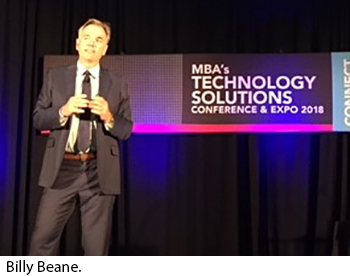
Baseball and the Art of Business Disruption
“…A man stands alone at the plate. This is the time for what? For individual achievement. There he stands alone. But in the field, what? Part of a team. Teamwork…looks, throws, catches, hustles–part of one big team. Bats himself the live-long day, Babe Ruth, Ty Cobb, and so on. If his team don’t field…what is he? You follow me? No one! Sunny day, the stands are full of fans. What does he have to say? “I’m goin’ out there for myself. But…I get nowhere unless the team wins.”
–Robert DeNiro as Al Capone in The Untouchables.

DETROIT–What can the mortgage industry learn from baseball?
Plenty, as it turns out.
Speaking here at the Mortgage Bankers Association’ Technology Solutions Conference & Expo, Billy Beane, general manager of the Oakland A’s, described how his “Moneyball” philosophy has been adopted by organizations of all sizes, across all industries, as a way to more efficiently and profitably manage their assets, talent and resources.
Beane noted he was a career .219 hitter in 10 professional baseball seasons, as a draft choice of the New York Mets in 1980. “I looked really good in a uniform, but looks didn’t translate into a career,” he said. “We put a lot of weight into perception–about what players should look like. We paid for the wrong skills.”
Beane noted, for example, the insurance industry already uses statistics to determine probabilities, which is why teenage males have the highest insurance rates. He said usable baseball data dates back to 1850–“usable, interpretable statistics. But we’ve never used them. We simply decided to use statistics to build a baseball team. You can build a baseball team using numbers.”
As depicted in the best-selling book Moneyball, the Oakland A’s engaged in “corporate arbitrage,” applying quantitative hedge fund principles to build a winning baseball club.
“We were valuing the wrong skills,” Beane said. “And as a low-paying baseball club, we were able to take advantage of the situation….we took things that already existed and did things differently.”
The takeaway from Moneyball, Beane said, is disruption. “We [used to] pay people for stealing bases, which doesn’t lead to runs,” he said. “What we should be paying people to do is for the ability to get on base–that leads to runs. The best players we ever had were the ones who didn’t look good in a uniform.
In 2002, Beane said, “we won 100 games with people who could hit home runs and get on base. And we did it again the next year.” Since 2002, the A’s have won six division titles.
Soon, every Major League Baseball team adopted the Beane model in some way. But Beane took it one step further, interpreting data in a different way. “There is a gap between actual statistics and our proprietary measurement system.”
For example, Beane created a hypothetical situation in which David Ortiz, the former hitter for the Boston Red Sox, hits a “gapper” line drive that results in a diving catch by Mike Trout of the Anaheim Angels–a situation that only occurs 3 percent of the time according to historical statistics.
“Ortiz gets penalized for a great hit because it was caught; his batting average goes down,” Beane said. “Trout gets no statistical credit for his great play. But the pitcher–who threw a terrible pitch that got hit well–gets rewarded for this because he gets an out and his earned run average goes down.”
Beane said the A’s used this to rethink their approach to selecting players. “The A’s traditionally drafted players, 50 percent from high school and 50 percent from college,” he said. “Paul [DePodesta, Beane’s assistant general manager and computer guru] figured out that college players had a 50 percent better chance of making it into the big leagues than high school kids, so we eliminated high school kids.”
The result of the 2003 A’s draft was 13 players who eventually made it to the major leagues; the next highest success rate was the Chicago White Sox, with nine.
“It wasn’t what we did; it was how we did it,” Beane said. “Baseball is now run as a meritocracy. We have geeks running baseball teams, and the teams are better run and the game is more enjoyable and profitable. We proved that playing the game is not a criteria for doing the job. I’m looking to hire the same people as you are.”
